“ThreeSixty City” Project in Lingayen Bay Pangasinan

Waterfront developments are crucial for creating attractive public spaces that improve the quality of life for people while offering economic opportunities and ecosystem services like flood protection and water purification. They are an important aspect of urbanisation. However, urban planners face various challenges with waterfront developments such as imminent threats from climate change and constantly evolving lifestyles.
To mitigate these, urban planners can integrate climate-resilient measures into the planning and design of waterfront developments. Protective barriers, green infrastructure, and sustainable development practices that reduce the impact of human activity on the environment are all necessary strategies waterfront developments should seek to adopt.
It is crucial that we as urban planners take steps to protect them from the impacts of climate change. Doing so will ensure that these areas continue to contribute to the well-being of our cities and communities economically, socially, and environmentally for generations to come.
At CPG Consultants (CPG), the Urban Planning team executes high-level planning strategies to create successful urban waterfront spaces. In adopting a three-pronged development strategy that aims at understanding the local communities and respecting the historical past of the location, the team also creates a sustainable environment and enhances the economic value of the development. Such strategies also help to enhance intrinsic qualities and breathe new life into the identities of these waterfront communities, an example of how the company use a three-pronged development strategy can be seen in one of its projects, the “ThreeSixty City” in Lingayen Bay, Pangasinan, Philippines.
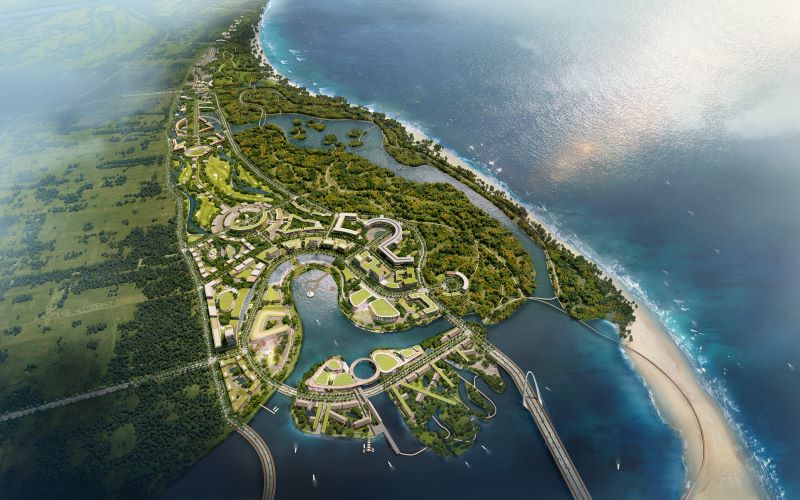
Waterfront Special Economic Zone Development in the Province of Pangasinan, Philippines
About 180 hectares of foreshore land in Lingayen, the provincial capital of the Pangasinan province in the Philippines, would be developed into a new waterfront Special Economic Zone (SEZ).
Located in the northern part of the Philippines, Pangasinan is renowned for its picturesque beaches and vibrant cultural heritage, the province's rich waterfront history stretches back to pre-colonial times when the Pangasinan people showcased their exceptional seafaring skills, navigating the waters of the Lingayen Gulf and the South China Sea to successfully engage in extensive trade with diverse cultures and honed their fishing expertise.
Leveraging on the historical prosperity of the waterfront, it remains a vital space upon which people's livelihoods depend, and it serves as a nexus for social and economic activities.
Restoring the Waterfront Development
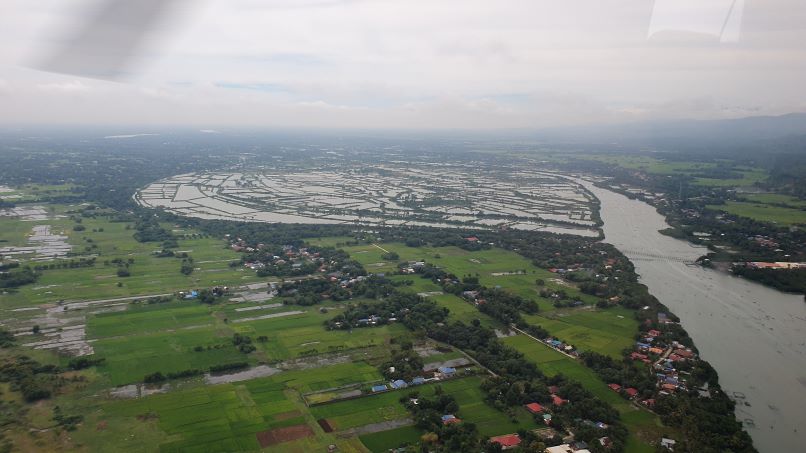
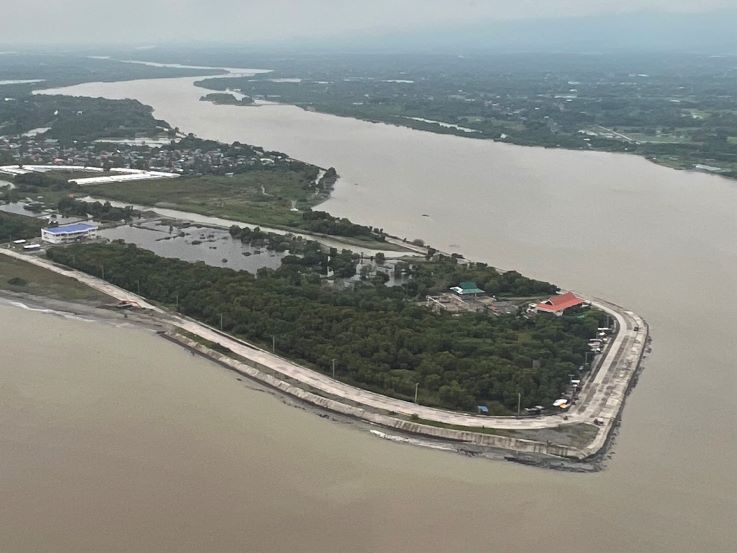
Views of the Limahong Channel where bank stabilisation work is taking place.
The coast of Lingayen Bay continues to attract many tourists drawn to Pangasinan's remarkable maritime history and stunning beaches. However, amidst the increased development, the natural environment has suffered from neglect and insufficient upkeep over the years. Compounded by the impacts of climate change, current coastal protection efforts need to be improved to counter the rapid degradation.
Amidst the various measures that CPG’s urban planning team proposed to address these concerns and restore the waterfront, one crucial aspect is the rehabilitation of the wetland areas, creating a designated wetland reserve that serves as a habitat for migratory birds. Additionally, the team curated paths within the wetland to allow people to enjoy the space while minimising the environmental impact safely.
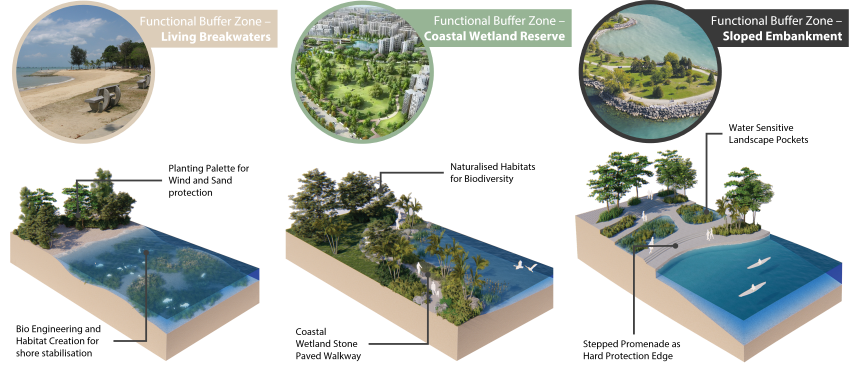
Functional Buffer Zones Protection Techniques
Another essential step is desilting the Limahong Channel, followed by riverbank reclamation. By implementing a hard embankment along the river, the area can be safeguarded against storm surges, ensuring the protection of waterfront properties. Furthermore, constructing a coastal road on a slightly elevated dike would facilitate seamless connectivity along the waterfront.
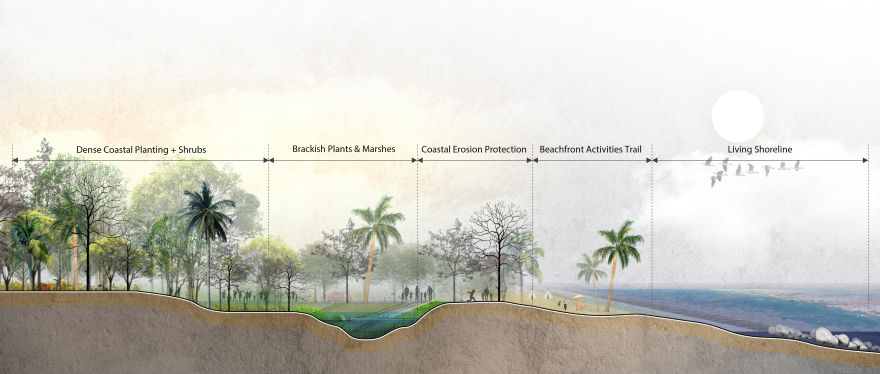
Limahong Wetland Reserve Coastal Protection Section
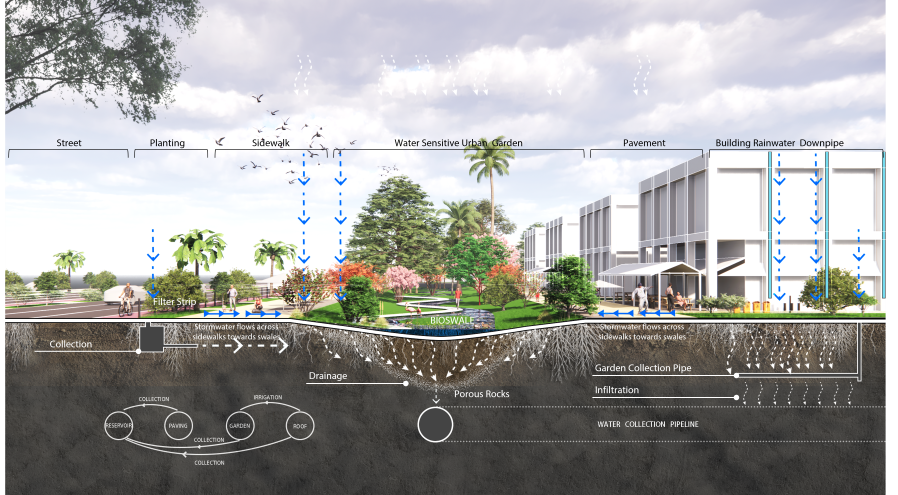
Inland Development Buffers to mitigate stormwater runoff
Through these combined efforts, it is hoped that the deteriorating condition of the coastline can be reversed, allowing for the preservation of the natural environment and the continued enjoyment of Pangasinan's unique maritime heritage by both residents and visitors alike.
To ensure the continued prosperity and success of the Lingayen waterfront development, the three-pronged development strategy will focus on using three approaches: Innovative, Immersive, and Inclusive to enhance environments for communities to thrive along these new waterfronts.
The aim is to create a user-centric, sustainable, urban living lab environment that inspires and provides unique and memorable experiences - Rodeo Cabillan, Vice President, CPG Urban Planning Team
Innovative
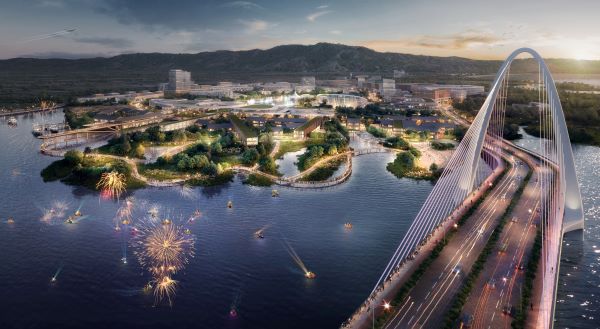
Entering three-sixty city via Tawalisi Crest over the Limahong Channel, overlooking the duty-free wetlands.
The “Innovative” approach focuses on testing innovative waterfront urban solutions within the SEZ development. Specifically, attention is given to the areas of energy, circular economy, and digital infrastructure, aiming to harness the power of the waterfront and enhance its natural beauty.
In the wetland park area along the Limahong Channel, a duty-free and commercial zone is seamlessly integrated with the waterfront, blending harmoniously. These transition spaces between the development and the waterfront serve as public areas for shoppers to enjoy the natural environment. The duty-free development is themed to capitalise on the waterfront's qualities, incorporating green infrastructure to minimise carbon footprint.
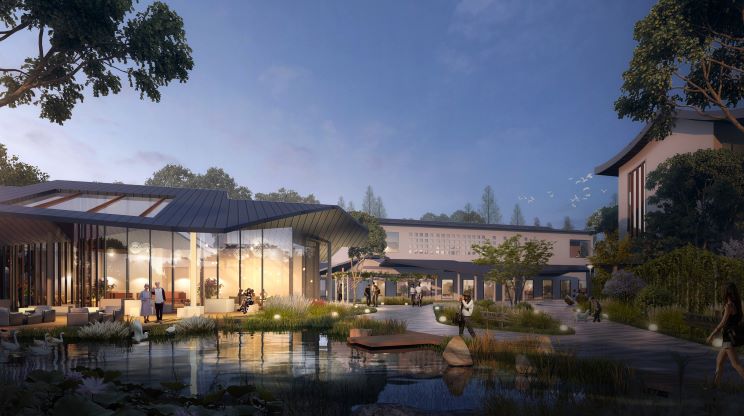
Wetland Duty Free Complex
To rehabilitate previously neglected open spaces, the CPG Urban Planning team implemented Water Sensitive Urban Design (WSUD) within the developments. This involves incorporating elements such as green roofs, rain gardens, and bioswales into the urban landscape. These features aid in managing stormwater, reducing the urban heat island effect, and improving air quality, contributing to the overall revitalisation of the waterfront area.
The overall objective is to align the project with creating a vibrant business retail environment that boasts a distinguished natural site character.
Immersive
An immersive experience for the users comes from an ecologically sensitive design that promotes a harmonious coexistence with nature. Establishing a coherent green-blue network where natural landscapes and water elements seamlessly blend creates an environmentally conscious and enjoyable experience for visitors.
Implementing an Eco-estuarine Green Corridor plays a pivotal role in the development. It commences from the eastern part of the project at the Tawalisi Crest, where a symbolic link bridge spans the Limahong Channel, allowing for both vehicle and pedestrian crossings. It is an excellent gateway into the new waterfront SEZ development, providing direct access to public promenades and civic plazas along the marina (Emerald Bayfront Cove). These areas present exceptional opportunities to create a landmark entrance across the riverfront, leaving a lasting impression on visitors.
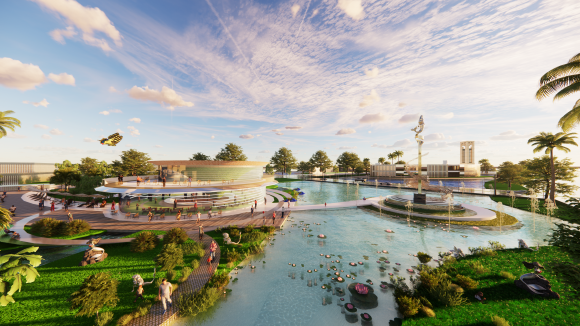
Siren Statue Floating Park – paying homage to the folklore of Pangasinan, set in the context of a community park by the waterfront.
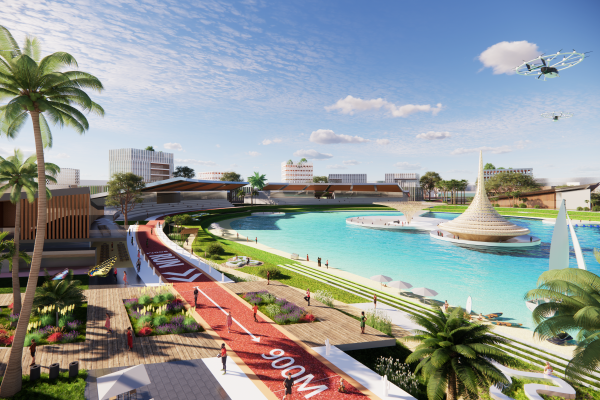
Emerald Bay Cove Marina – A multi-functional public promenade along the waterfront where a variety of recreational-leisure activities can take place. A floating stage with a symbolic statue is positioned in the middle of the marina, fully activating all dimensions of the marina.
Functioning as the backbone of the entire waterfront development, the Eco-estuarine Green Corridor serves as the main spine that connects and unifies the three distinct district zones. This continuous stretch of green space and waterway acts as a unifying element, ensuring seamless integration and enhancing the overall coherence and connectivity of the project.
Within each district zone, there are three distinct waterfront development themes, running parallel to the waterfront. The first hub showcases a commercial-agro character with a focus on wellness, offering a diverse range of amenities and services that promote health and well-being. The second hub features a golf course, providing a recreational haven for enthusiasts and enhancing the area’s appeal. Finally, the third hub boasts a central park, aptly named Sirens’ Central Park, which encompasses a central lake. This area radiates an atmosphere of relaxation and leisure, providing a tranquil oasis amidst the vibrant waterfront development.
Inclusive
Finally, the “Inclusive” approach as part of the development strategy aims to facilitate a seamless eco-experience within the walkable precinct. One notable initiative is the establishment of the Limahong Wetland Reserve, a protected area spanning 13 hectares. This reserve serves multiple purposes, acting as a natural recreation space for residents and tourists.
Moreover, it plays a crucial role as a habitat for numerous species of wildlife and plants, fostering biodiversity and supporting the ecosystem. The wetland reserve is particularly significant as a critical breeding ground for migratory birds, attracting these beautiful creatures during their seasonal journeys. Additionally, the reserve serves vital ecological functions such as flood control and water filtration, contributing to the area's overall environmental balance and sustainability.
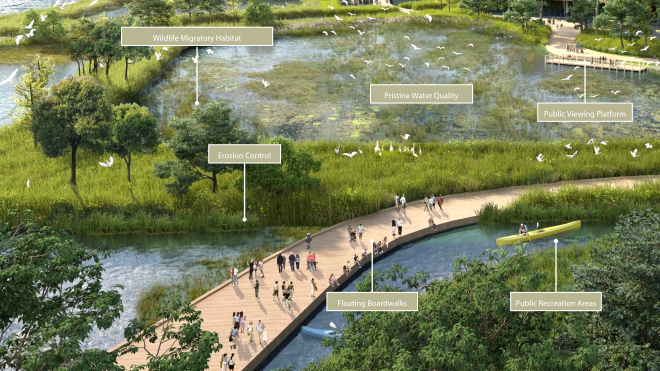
Waterfront Wetland Boardwalk for the public to be amongst nature.
Waterfront developments retain their timeless importance, serving as valuable spaces contributing to the fabric of communities. Urban planning and design play a pivotal role in addressing the challenges posed by urbanisation and climate change. By adopting sustainable and resilient approaches, we can create livable communities that withstand the changing environmental conditions. The CPG team remains committed to leveraging its expertise and knowledge gained from local and international projects to embrace best practices in revitalising waterfront developments and public spaces.
This article is authored by:
 | Rodeo Cruzado, Vice President |



